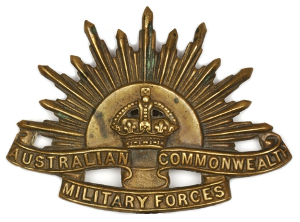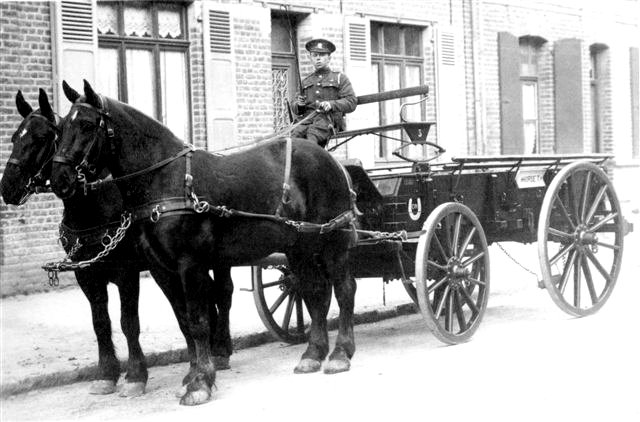Topic: CEF

In the Trenches
 Trench Warfare; A Manual for Officers and Men, J.S. Smith, Second Lieutenant with the British Expeditionary Force, E.P. Dutton & Co., 1917.
Trench Warfare; A Manual for Officers and Men, J.S. Smith, Second Lieutenant with the British Expeditionary Force, E.P. Dutton & Co., 1917.
On relieving the fire trenches, the men should make no noise, and rifles must be carried so that they do not show over the parapet. This is necessary even if enemy's trenches are at a distance, as there is always the possibility of a listening or observation post being quite near.
Each man should pair off with one of the party occupying the trench and find out from him any points which may be useful.
A commander should consult the officer or N.C.O. in charge of the outgoing party and obtain the fullest information possible in connection with the position. Particular points on which information should be obtained from the outgoing officer are generally:
(a) behavior of enemy during period preceding relief and any point in their requiring special information, such as enemy may have cut wire as though preparing line to attack;
(b) machine gun implacement may be suspected at some particular point;
(c) anything ascertained by patrols about ground between firing lines, thus avoiding unnecessary reconnoissance
(d) any standing arrangement for patrols at night, including point at which wire can best be passed, ground to be patrolled, or place where they can lie under cover;
(e) any parts of trench from which it is not safe to fire. Such positions are apt to occur in winding trenches, and are not always recognizable in the dark;
(f) special features of trench, recent improvements, work not completed, dangerous points (on which enemy machine guns are trained at night), useful loopholes for observation;
(g) places from which wood and water can be safely obtained;
(h) amount of ammunition, number of picks, shovels and empty sandbags in that section of the line.
Information on these points cannot always be given by word of mouth. Written notes and plans should, therefore, be handed over to a platoon commander taking over for the first time.
In the meantime the incoming party should fix bayonets and all go temporarily on sentry at posts taken over. Occasional shots should be fired, so that the enemy's suspicions may not be roused. The outgoing party then starts back, and when clear, the relieving party should be numbered off and sentries posted and dugouts allotted. When practicable sentries should be taken from the dugout closest to his post.
By day the number of sentries varies, butshould not be less than one in six. The platoon sergeant is responsible for changing sentries, who are generally not on duty more than one hour at a time, unless under exceptional circumstances. When the maximum amount of labor must be obtained from the battalion holding the line, sentry duty is of any length that fits in with working arrangements. Every man must see that he has a good clear position for all directions. Section commanders must satisfy themselves that men have done this and reported such. When these arrangements are completed, word must be quietly passed down for men not on sentry to stand clear, and they are all not in that position again until the "Stand to" hours, generally the hour nearest dusk and the hour before dawn.
After dark, unless the moon is bright, rifles should be kept in a firing position on the parapet, and all men not on duty should keep rifles with bayonets fixed while in the trench.
Observation
Continuous survey of the enemy's lines through disguised steel loopholes should be made when the trenches are being held for any lengthy period, and such loopholes must always be sideways. Sites may be chosen by day, and made and disguised by night. Two steel loopholes about 3 yards apart enable a man with leveled rifle to wait by one while another with field glasses watches for target through the other. An observer watching persistently through glasses in complete security should make himself so familiar with the look of the opposite trenches as to enable him to observe any alteration in the enemy's wire entanglements, or notice immediately if a new sap has been run out from the enemy trenches under cover of night. He should watch points suspected of being machine gun implacements, and especially at night when the flashes can be detected. Observers should be told what marks, etc., to look for on men exposing themselves, and any result of these observations at once reported to the officer or N.C.O.
Inspection
A platoon commander should make frequent examination of trenches; at least once daily, go around with platoon sergeant and section commanders and decide on the necessary work to be done. Section commanders are responsible for carrying it out.
Before handing over a trench, a platoon commander should make a rigorous inspection to see that it is as clean as possible and that latrines are left in a satisfactory state. This includes the removal of old tins, paper, scraps of food, etc., which should be buried or burned, if possible. Empty cartridges should also always be kept cleared out, as they get imbedded in trench floors and hinder subsequent digging.
Joseph Shuter Smith
Joseph Shuter Smith was an American author born in Philadelphia in 1893. He spent his childhood in Alaska during the Gold Rush and spent his years before the Great War as a lumberjack, miner, surveyor and cowboy. In 1914, continuing his adventurous streak, he went to Canada and enlisted in the Canadian Expeditionary Force, declaring his birthplace to be Port Hope, Ontario (with next of kin in Oakland, California). Smith enlisted with the 29th Canadian Infantry Battalion at Vancouver. He served in France and Belgium as a soldier in the CEF and, after being commissioned in August, 1916, as an officer of the British Army with The Royal Scots (Lothian Regiment). He resigned his Imperial commission after a year to return to the US and enlist in the American Army. Joseph Smith also wrote the memoir: Over There and Back in Three Uniforms; Being the Experiences of an American Boy in the Canadian, British and American Armies at the Front and through No Man's Land.





 Combat Recon Manual, Republic of Vietnam; 1970
Combat Recon Manual, Republic of Vietnam; 1970






 Journals of Major Robert Rogers, as published in a 1769 Dublin edition.
Journals of Major Robert Rogers, as published in a 1769 Dublin edition.




 It's the Army's revolutionary new way of dealing with rations.
It's the Army's revolutionary new way of dealing with rations. 
 The Army formally adopted a set of Principles of War in 1921 that endure today. Briefly stated they are:
The Army formally adopted a set of Principles of War in 1921 that endure today. Briefly stated they are:
 I have the honour to inform you that in considering the historical significance of the cap badge of the
I have the honour to inform you that in considering the historical significance of the cap badge of the 



 In a war of revolutionary character, guerrilla operations are a necessary part. This is particularly true in a war waged for the emancipation who inhabit a vast nation.
In a war of revolutionary character, guerrilla operations are a necessary part. This is particularly true in a war waged for the emancipation who inhabit a vast nation. 


